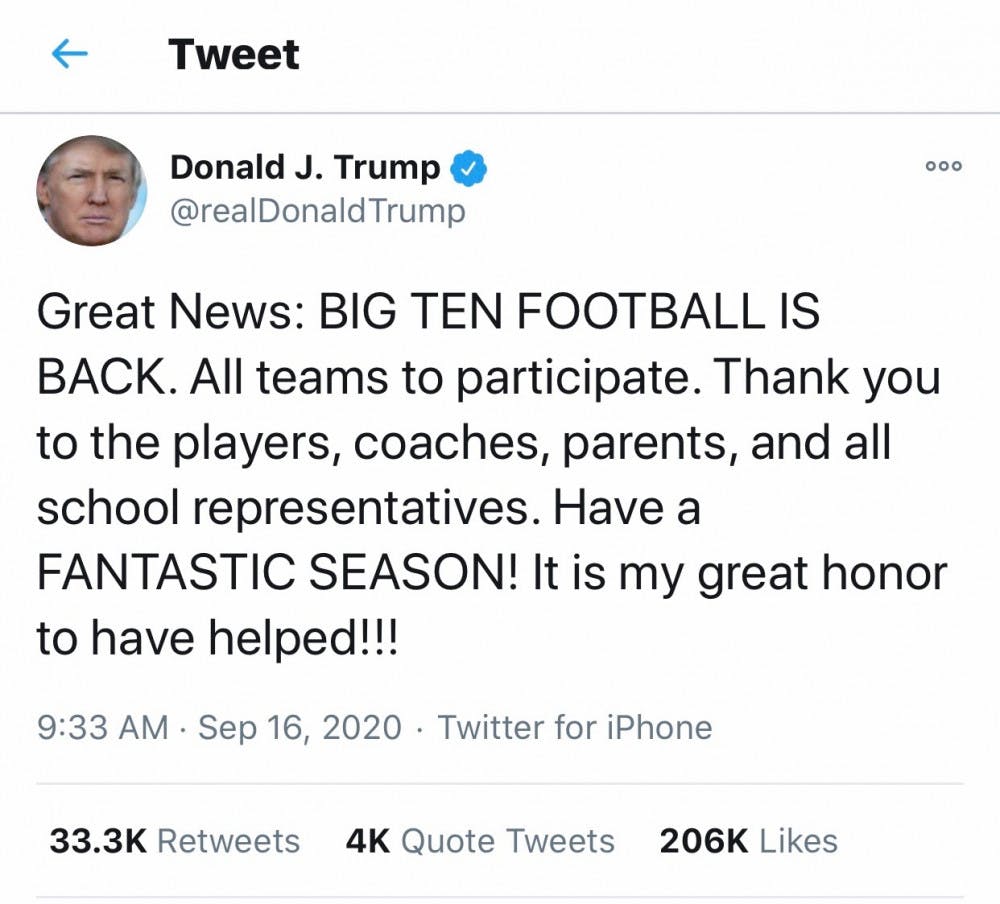“Great News: BIG TEN FOOTBALL IS BACK,” President Donald Trump announced via Twitter on Sept. 16, confirming that the most prominent college football division would return for a nine-week season starting in late October.
Great News: BIG TEN FOOTBALL IS BACK. All teams to participate. Thank you to the players, coaches, parents, and all school representatives. Have a FANTASTIC SEASON! It is my great honor to have helped!!!
— Donald J. Trump (@realDonaldTrump) September 16, 2020
The decision to reinstate the season came as a surprise to many, since it was initially canceled less than two months ago due to Covid-19-related safety concerns. Many see the president’s decision to advocate for the league as an attempt to garner support before the Nov. 3 election, since Big Ten Conference fans may be swayed by Trump’s decision.
Football and the American presidency are not entirely separable institutions — the president’s military aides literally carry around an emergency briefcase coined the “nuclear football.” The link between the office and the sport can be traced as far back as 1905, when Theodore Roosevelt personally encouraged football’s reform amid plans to abolish the game after 18 players died that season. Furthermore, former President Barack Obama’s first interview was centered around how to redesign the playoff system. Donald Trump may be taking a page from his predecessors’ books, using the all-American game as a lifeline to win points with the electorate.
“It was me, and I’m very happy to do it, and the people of Ohio are very proud of me,” Trump announced during the 2020 presidential debate.
Why did the President single out Ohio? There are two possible answers. On the one hand, Ohio was slated to play the first game of the season on Oct. 24, right before the election. Just hours before the first presidential debate, Republican Governor Mike DeWine announced on ABC that Ohio was still a swing state. The state swung in favor of Donald Trump in 2016 but had voted blue in the two elections prior. Trump won Ohio in 2016 by a margin of 8.13 percentage points, which was the second largest margin of the states that flipped red after Iowa, another swing state that could make or break the president this election cycle.
As of now, Donald Trump and Joe Biden are neck-and-neck in both states, with margins of less than 2%. By giving citizens their favorite all-American pastime back amid the craziness of the pandemic, Donald Trump makes an effort to brand himself as the man to bring back normalcy, and that could make all the difference when the polls are so close.
The Big Ten Academic Alliance currently contains 14 schools, most of which are in swing states, including Ohio State University, University of Iowa, University of Michigan, Michigan State University, University of Minnesota, Pennsylvania State University and University of Wisconsin-Madison. Almost half of Big Ten Schools are in six of the 11 supposed swing states for the 2020 election. For Trump, a victory in all six of these states would earn him 70 crucial electoral votes.
When Trump announced that he was bringing football back to these schools, he was lagging behind in the Michigan, Minnesota, Pennsylvania and Wisconsin polls by a range between 5% and 9%. And it doesn’t look like that gap has closed in any of these states — yet. But in 2016, Donald Trump won Iowa, Michigan, Ohio, Pennsylvania and Wisconsin, each by less than 9.5%.
Given football’s popularity nationwide, it comes as no surprise that collegiate football holds a special place in the heart of many Americans. What remains unclear is whether the Big Ten can help preserve the Trump presidency — and whether protecting this American tradition will be enough. In the past, presidents have gained popularity by protecting the integrity of the sport and its players. But over a month out from Trump’s “great news,” not much has changed in the polls.
Comments




